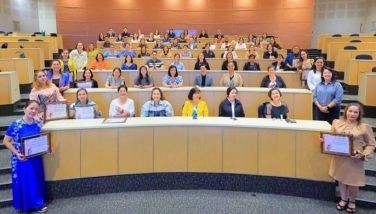SPECIAL FEATURE: Redeeming Argao’s lost glory
CEBU, Philippines - For a town which thrives on fishing, it is ironic to know that the very source of this livelihood has almost become a wasteland.
Supposedly, marine sanctuaries are a habitat for fishes and other sea creatures, but Argao’s corals have turned into rubbles, which have resulted to adult fishes migrating to other areas.
If there are fishes left, these are mostly juveniles, and the handful live corals are being attacked by the deadly crown of thorns (COT). These were the findings of the Knight-Stewards of the Sea, Inc. (Seaknights) divers, who conducted an assessment of Argao’s four marine sanctuaries last week.
William Villaver, a resident marine biologist of the Seaknights, opined that the areas were either overfished or were subjected to destruction in the past years, forcing the adult fishes to leave and find a safe sanctuary.
The Seaknights, a non-government organization, was invited by the local government of Argao to check the status of its coral reefs. Mayor Edsel Galeos said the local government wanted to know the extent of the rehabilitation that the coral reefs in the area need. About 30 percent of locals in Argao are into farming and fishing. After knowing that there is almost no more fish in their seas, Galeos said they might as well start providing alternative livelihood for the local fishermen while they rehabilitate the people’s source of food.
Then and now
Argao, about 68 kilometers south of Cebu, used to be one of the province’s favorite dive destinations. At one point, a resort in Lapu-Lapu City had to build a sister beach resort in the said town to accommodate the influx of divers who wanted to see the town’s underwater attraction. This was in the 80s when cyanide and compressor diving were still alien to the locals.
“We used to be the number one diving spot in Cebu. We had green turtles then, and so many others,†recalled Galeos, referring to the Casay Marine Sanctuary.
However, from the photographs and videos of Casay presented by the Seaknights to Galeos, department heads and some councilors last Monday, it appeared that the famous dive site has lost its glory. There are still corals but some are dead, yet still clinging on the reef’s grand wall. There were also COTs sticking out of a dying coral, and not one adult fish was in sight (all were juveniles). There were also no more green turtles swimming towards the deeper part of the sea. Villaver said Casay was “possibly†a victim of cyanide fishing.
Argao has 10 marine sanctuaries, the Seaknights were only able to survey four of these and the findings are practically the same. But there are still signs of biodiversity meaning, there is still a chance that these can recover assuming the government would strictly implement its laws on marine environment, said Villaver.
The evils
Anthony Villegas, director of Argao’s Bantay Dagat, said he does not believe cyanide fishing is still practiced to this day. He said he has eight men who regularly monitor these 10 sanctuaries for illegal fishing methods, and the common report they get are commercial fishing and compressor diving and these do not come from their own turf but from other localities. Villegas, who has been with the Bantay Dagat since 2001, said they work round-the-clock to ensure that their seas are protected. Villegas believed that the destruction happened long before he assumed as Bantay Dagat chief.
The crown of thorns (COT), a type of starfish that sucks the life of a coral for as fast as four inches per day, has also thrived in three of the four sanctuaries that the Seaknights had surveyed. More than a hundred of COTs were retrieved in just less-than-an-hour dive. Veteran diver Alfie Fernandez explained that an outbreak of COTs means that there is an imbalance in the ecosystem. Villaver pointed out that Tambuli, a kind of shellfish, and Napoleon fish feed on COTs, but since these are no longer present in Argao, there is a big chance that these coral predators would grow exponentially.
The inactive fisherfolk organizations and lack of community involvement on marine-protection programs could also be blamed for the dying marine resources of Argao. Villegas said a few years ago the local fishers, through their respective organizations, were provided with alternative livelihood like livestock raising, weaving, cow fattening, among others, by the Community-based Coastal Resource Management Program (CCRMP). “Active kaayo ang mga baranggay ato. Pero pagkawa sa CCRMP, nawa pud sila,†said Villegas. He also noted that the earnings gained from the livelihood program were not enough to sustain the family of a local fisher.
The possible solutions
It may take several years to grow a single coral, but only about six months to regenerate a healthy population of fishes, said Villaver. Again, “assuming there is no disturbance†in the surrounding, he said.
He said that if Argao wants to revive its old underwater scenes, it must have a “complete ecosystem†which has healthy mangroves in the shorelines and seagrasses in the seabeds.
And while the present administration is open to the idea of resuscitating its marine environment, Villaver said the problem now is the implementation of its programs and laws governing its resources. The local fishers should not be left out with its plans, too, hence the Seaknights recommended, as it usually stipulates in its every assessment, that the Argao government utilize its idle fishponds to be used by the local fishers.
The Seaknights noted that there are several fishponds in Argao which are no longer used by their owners. Villaver said as per Republic Act 8550 or the Fisheries Code provides that if a fishpond, which sits on a public domain, is not used for 10 years, it must be returned to the government. He said it should either be converted into source of income for the displaced fishers or be planted with mangroves.
Every sanctuary must have its own fishers’ association, which then operates and takes care of said property, he said. This way the government does not have to send its Bantay Dagat to areas which already have their own local wardens.
Redeeming the lost glory
Fernandez said he was sad for Argao’s natural resources. But it can still “redeem the lost glory†if it does not stop from just knowing the problem. “Dili na problema kung wa kasabot. Ang problema kung nakasabot pero di mosabot,†he said.
For his part, Galeos, who is on his third and last term as mayor, said he called on his department heads and councilors to listen to the assessment of their marine sanctuaries so they will know what to do next.
“This year we are crafting Argao’s Comprehensive Development plan for 20 years so we will know what will happen to Argao in 20 years, and it includes our marine sanctuaries,†he said.
Galeos said despite the destruction he still saw the beauty that lies underwater and he was glad to hear that there is still a chance to recover that lost glory, not only for eco-tourism but also for his people’s livelihood. He said private firms have also offered to adopt two of their sanctuaries, and he is considering the offer, especially that it is expensive to rehabilitate a single sanctuary. He said that by next year, he hopes to see the fishes back in the seawaters and in the next few years to come, they will be a top dive destination in Cebu again. — /QSB (FREEMAN)
- Latest
















